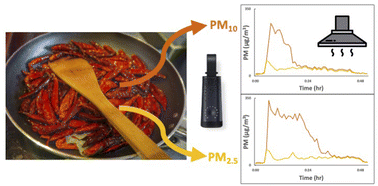Indoor particulate matter (PM) from cooking in UK students' studio flats and associated intervention strategies: evaluation of cooking methods, PM concentrations and personal exposures using low-cost sensors†
Abstract
Cooking emissions have been identified as a major source of indoor particulate matter (PM), which can contribute to severe health issues, including cardiovascular disease and lung cancer. Both cooking methods and use of extractors were investigated to assess their influence on PM concentrations and emission rates. The impact of PM residence times was also examined in terms of the operator's exposure. PM10 and PM2.5 were monitored by placing carefully validated low-cost sensors, with sufficiently high accuracies of 70.7% and 64.3% on PM10 and PM2.5, respectively, by compared to a reference instrument, in the kitchen areas of five student studio flats. Ranges and medians of mean concentrations of PM10 and PM2.5 of four studied cooking methods ranked (range (median) (μg m−3)) deep-frying (62–236 (151); 6–37 (30)), stir-frying (17–176 (63); 2–38 (7)), boiling (6–41 (17); 2–11 (4)) and steaming (7–23 (12); 2–7 (3)), respectively. The impact of using extractors on PM removal rates ranged between 10.5% and 63.0%. Extractors were shown to accelerate the post-cooking pollutant decay, which therefore resulted in shorter residence times. Personal exposure times also varied with cooking method and operator gender. Indoor PM exposure is associated with PM concentration, cooking duration and decay rate. Based on these results, cooking water-based dishes while operating extractors would improve indoor air quality and reduce PM exposure.

- This article is part of the themed collection: Indoor Air Quality


 Please wait while we load your content...
Please wait while we load your content...